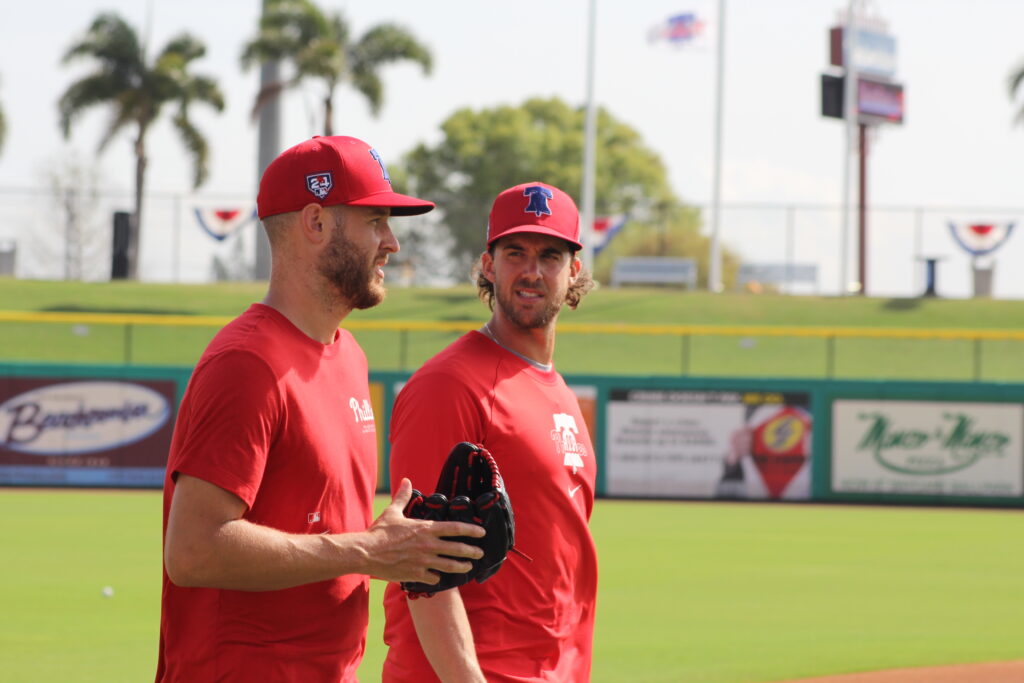

You can argue either way as to whether the Phillies have the most talented starting rotation in baseball. The Dodgers are tough to overlook. As are the Mariners. And a few others.
What’s hard to dispute is that the Phillies of recent years have had one of the most durable rotations — if not the most durable rotation — in the sport. Phillies starters ranked fourth across MLB in innings pitched last year, third the year before and fifth the year before. Two starters took down at least 199 innings last year, and another was north of 180.
Beyond the obvious advantage of having better pitchers take down more innings, the workload that Phillies’ starters have shouldered in recent years has been an enormous boost for the bullpen. That group ranked fourth, first and second in fewest innings pitched in 2024, 2023 and 2022, respectively.
The rotation’s workload has been an instrumental aspect of the club’s three straight postseason berths — however long or short their October stays lasted.
Can they count on that same advantage again in 2025?
Zack Wheeler and Aaron Nola have epitomized reliability for more than half a decade, with the 1-2 punch atop the Phillies’ rotation combining for exactly one full season under 180 innings pitched since the start of 2018. Wheeler threw 200 innings last regular season, and Nola was a misjudged fly ball by Brandon Marsh from doing the same. Anything too far off that standard this year would be an aberration, even with Wheeler turning 35 in late May.
Behind them, though, it’s less of a sure thing.
Ranger Suárez eclipsed 150 innings last regular season, but just 52 1/3 of them came in the team’s final 81 games — with a back injury sidelining him for most of August and clearly hampering him down the stretch, gutsy NLDS Game 4 performance notwithstanding. This is a contract season for Suárez, and the guess there is that the southpaw — or, perhaps more specifically, his representation — will want to proceed with caution whenever possible.
Cristopher Sánchez threw 181 2/3 innings last season, up from 149 the previous season (between MLB and Triple-A) and otherwise the most, by far, of his professional career. Can he take down another 180? Possibly, but that also assumes production at or near the level that ranked Sánchez seventh in the sport in fWAR last year. He’s certainly talented enough to do it — the Phillies rewarded his efforts with a four-year extension for a reason — but for his second full-workload season in the Majors, it’s tough to know for sure.
Jesús Luzardo has said he’s pain-free after missing the latter half of 2024, but his injury risk is a big reason why the Phillies gave up as little (Starlyn Caba and Emaarion Boyd) as they did to acquire him. And the club seems ready to factor Andrew Painter into its ideal rotation plans, which is good and well and deserved — but he missed all of last year after undergoing Tommy John surgery and, given his importance to the team in the long run, likely won’t be pushed.
It’s true that the Phillies have done a remarkable job of keeping their starters healthy — probably the envy of 29 other MLB teams, given the rate of pitcher injuries plaguing the sport and the paucity of quality starting pitching to summon in response. But how much of that is science, and how much of it is sheer luck, is anyone’s guess.
This isn’t to say that the Phillies should add more starting pitching. They shouldn’t. They have plenty of depth, beyond just those six.
It’s to say that such volume from the rotation for another year — which, again, would indeed fall in line with recent trends — shouldn’t be taken for granted. And neither should the current bullpen’s ability to handle any potential uptick in its collective workload.
That’s why they signed Joe Ross, who should spend the bulk of his time in the bullpen and could take down innings in the rotation when necessary. But is that enough? The relief corps, as currently constructed, consists of Jordan Romano, Orion Kerkering, Matt Strahm, Jose Alvarado, Jose Ruiz, Tanner Banks and Ross.
It’s not a bad group by any means. But, barring a majority of those names hitting or approaching uncertain ceilings in 2025, the Phillies’ bullpen is probably more equipped to handle workloads like it did in 2024, 2023 or 2022, rather than the volume most bullpens across the league typically do. Maybe the rotation keeps up the same type of volume it’s provided in years past, and that dynamic is viable. But it’s far from a certainty, and the Phillies shouldn’t operate like it is.
View Comments
Love Nola and Wheels. We know that Nola will give us about 200 innings. Hopefully he can hone in one of his secondary pitches as he struggled to execute his cutter and changeup last season. If he can get one of those secondary pitches back in addition to keeping his sinker on the corners and his four seamer up, he’ll have a good season.